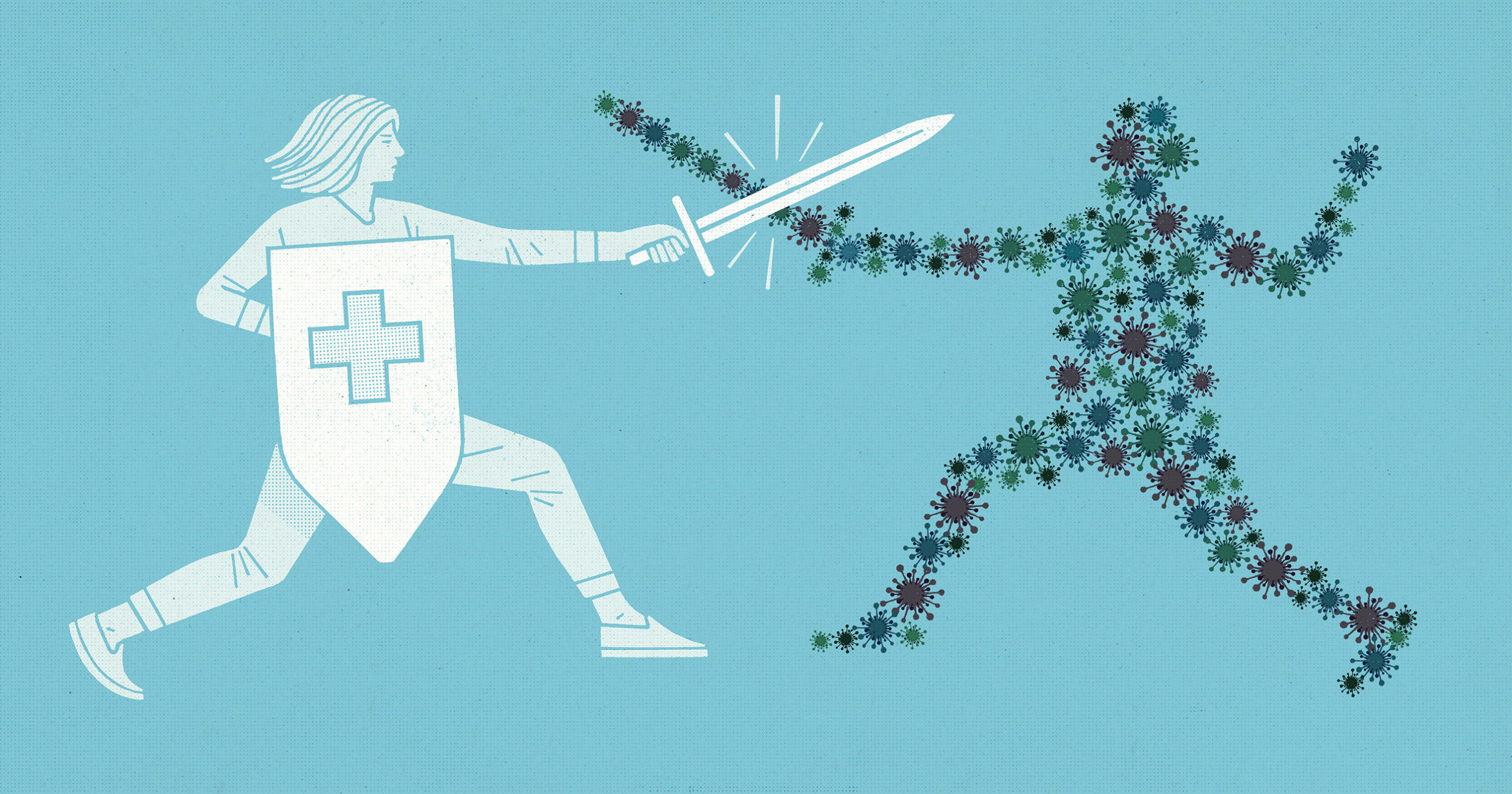
27 May THE RACE TOWARDS A (CORONAVIRUS) VACCINE
Before we dive into vaccines and the so-far developments, let’s start with the basics, namely the immune system.
The immune system is our body’s defense and attack system against any form of infection and is comprised of an interconnected network of proteins, cells, and organs. When our body is confronted with a pathogen, our immune system follows two main strategies; a generic response (innate immune response) and a more elaborate, complexed and targeted response (adaptive immune response). The generic (innate immune) response is the first line of defense and attack. If this first line is not successful in clearing off the pathogen, then the body has at least ‘bought some time’ to prepare its second line of defense and attack, the adaptive immune response system, which can develop a ‘specialized attack’ against the particular pathogen.
What we mean by the term ‘specialized attack’ is simply the making of (the now-popular) antibodies against microbes. Antibodies can recognize, ‘catch’ and eliminate the microbe. How are antibodies produced by the body? In a simplified explanation, a specialized type of immune cells, called APCs (Antigen-Presenting Cells), engulf (swallow up) the pathogen once they come across such invaders, chop it up and display portions of it (e.g. part of the viral proteins) on their surface (see image below). This chopped up part of the pathogen, called the antigen, is placed on a particular type of proteins on the surface of APCs (called MHC — major histocompatibility complex). These surface protein complexes (displaying the antigen) can in turn be ‘recognized’ and bound by receptors found on some other specialized type of immune cells, called the T helper cells. Once these T helper cells recognize and bind to the APCs, a whole cascade of events takes place which leads — on the one hand — to the production of specific antibodies against the pathogen (more accurately against the antigen) and — on the other hand — on activation of more immune ‘soldiers’ (such as cytotoxic T cells) in order to ‘fight’ the pathogen and the infection. In other words, antibodies are little proteins — produced by our specialized immune cells — able to recognize the pathogen and ‘call for help’.

When we say ‘recognize’ in biology, all what we mean is that the antibody binds to the pathogen’s piece (the antigen) because of certain characteristics which make the one attractive to the other (such as opposite charges, complementary shapes — like a key-lock relationship — etc.). Exactly here lies the purpose of a vaccine; getting people to make such ‘watchmen’ antibodies without those people having to actually get the disease. Nevertheless, it is extremely important that the antibody is ‘attractive’ to the specific pathogen (antigen) ONLY. Otherwise it could end up recognizing our body’s proteins and start attacking our own body (as is the case with autoimmune diseases).
…BACK TO THE COVID-19 VACCINES’ LANDSCAPE…
Although constructing a vaccine is definitely not a ‘breeze’, there is a multitude of different ways to make it. On top of the ‘classic ways’ — which are currently being tested (e.g. using a dead or a weakened virus) – , there are some ‘novel ways’ too being tried out and which were never used before to establish a vaccine (e.g. mRNA and DNA vaccines which use pieces of the virus’s genetic material). As expected, each way has advantages and disadvantages.
Some of the main vaccine technology-platforms currently being tested are the following:
1. Inactivated (killed) virus
2. Weakened virus
3. Viral proteins
4. Virus-like particles (VLPs)
5. Viral vectors
6. DNA or mRNA
Before scientists can start research in order to create an antibody, they need the genetic ‘code’, the genetic sequence of the virus. The sequence of SARS-CoV-2, the coronavirus that causes COVID-19 disease, was published on the 11th of January 2020, triggering intense global R&D activity to develop a vaccine against the virus. Antibodies can be produced to target any of the virus’s proteins, however, it seems like the S proteins (standing for the Spike proteins) found on the surface of SARS-CoV-2 are — for the moment — the most promising targets , as they are easily ‘visible’ to other cells and they are the ‘key’ to cell entry.
…Let’s elaborate a bit on each platform…
1. Inactivated virus
Currently being researched by Sinovac Biotech, Beijing Institute of Biological Products and Wuhan Institute of Biological Products. Scientists ‘kill’ the virus (either be heating it or by adding chemicals, such as formaldehyde).
Advantages:
· Inactivated viruses can elicit a strong immune response because (although dead) they still look like a foreign intruder to the immune system
· Safely and effectively used for other viruses, such as the hepatitis A and some flu vaccines.
Disadvantages:
· Finding the right balance of dead but not disfigured virus (in order for the body to be able to still recognize the intruder and elicit an immune response) can be tricky. A lot of trial and error is needed, testing different chemical concentrations, etc.
· High initial quantities of live virus are needed, so that scientists end up with a high load for injection (the virus is dead and cannot make more copies of itself once injected).
2. Weakened virus
Live attenuated virus, currently being researched in Codagenix collaborating with Serum Institute of India.
This is a version of the virus that is still ‘alive’, so it can infect cells, make copies of itself, etc. but it cannot make the person getting the injection sick. Scientists usually make such vaccines by passing the virus through cells in a dish multiple times. The virus has to keep copying itself, so it will inevitably pick up mutations. Scientists then select for weakened viral strains and use them.
Advantages:
· These types of vaccines have in the past proven safe and effective for smallpox, chickenpox, rotavirus, and MMR (Measles, Mumps, and Rubella) and provide often a strong, lasting immunity.
Disadvantages:
· The virus is still ‘alive’ hence this type of vaccine is considered ‘riskier’.
3. Viral proteins
Currently being researched by GSK & Sanofi.
This is where scientists inject pre-made viral proteins (or parts of proteins), which have been ‘grown’ in the lab. The main candidates are the S (Spike) protein or even just the part of the S protein (called the Receptor Binding Domain) that binds the human cell’s ACE2 receptor.
Advantages:
· Similar vaccines against the original SARS virus have been shown to be effective and safe in monkeys (but have not been tested in humans).
· Viral protein-based vaccines have been tested, approved, and are currently in use, for other viruses like shingles and hepatitis B.
Disadvantages:
· ‘Lab-expressed’ proteins can be resource-intensive. Depending on the protein, the yield can be very low and taking care of the cells (which produce these proteins) can be time-consuming. Moreover, depending on the type of cells used, the proteins that are made might have different modifications and/or might not fold properly.
· This way the scientists are only introducing a very small part of the virus, meaning it might be necessary to give the immune system an additional signal that this little protein they are introducing is indeed a threat. As a result, these protein vaccines might require adjuvants (immune-stimulating molecular companions) and multiple doses before they can be effective.
In this case, Sanofi is producing the spike protein, while the GSK the adjuvant (the chemicals co-injected with the proteins to make them more ‘immunogenic’ (i.e. get the immune system to see the proteins as foreign and start making antibodies against them).
4. Virus-like particles (VLPs)
Currently being researched by Medicago.
These are basically ‘empty’ viral particles. A coronavirus’s particle consists of a single strand of RNA (i.e. the viral genetic code) encoding the virus’s blueprint, surrounded by an oily (lipid) membrane embedded with proteins (e.g. those Spike proteins, but also other proteins too). VLPs are the protein-embedded membrane without the viral genetic information inside. Without that viral genetic information (i.e. the genetic code, its RNA), there is not really a virus, but it looks like there is.
Advantages:
· The HPV (Human Papilloma Virus) vaccine works like this.
Disadvantages:
· It can be laborious to make VLPs, as scientists need to find the right balance of viral parts.
5. Viral vectors
(Oxford University’s Jenner Institute, India’s Serum Institute, AstraZeneca, Johnson & Johnson).
One of the genes from the coronavirus is ‘cut out’ of the coronavirus’s genome and ‘pasted’ into the genome of a different virus that has been weakened and cannot cause disease, such as measles or an adenovirus (a type of virus responsible for some colds).
Advantages:
· This technique is attractive because scientists can just swap out the gene for any virus.
Disadvantages:
· The body might develop an immunity for the vector as well as (and hopefully not instead of) for the virus. So if you give a person a second vaccine with the same vector, they might over-react and destroy the virus without getting a new immunity.
6. DNA vaccines
Currently being researched by Inovio Pharmaceuticals.
Instead of relying on a viral vector, these vaccines introduce just ‘bare’ DNA. The whole point here lies in the fact that in order for a human to ‘make’ any protein (here the desired viral S protein which will trigger the production of an antibody), it needs to start having the ‘instructions’ for it, meaning the DNA code. Once the cells have the DNA ‘instructions’, they can then use a highly delicate process to ‘transform’ DNA into ‘messenger RNA’ (mRNA) (named like that because it carries the message for the protein production) and then ‘read’ or ‘translate’ this mRNA code into the desired protein, using protein-making complexes called ribosomes.
To convince the DNA to actually go inside the cells, scientists can use a technique called electroporation, where they inject DNA and then apply electric charge to open up temporary pores in cell membranes to allow DNA to ‘slip’ inside.
Advantages:
· Cells can make many mRNA copies from a single DNA copy, and each mRNA copy can be used over and over by the protein-making machinery, the ribosomes. As a result, scientists can get cells to make a lot of protein from this type of vaccines.
Disadvantages:
· DNA vaccines have never been successfully used in humans before.
7. mRNA vaccines
Currently being researched by Moderna collaborating with the NIH’s National Institute of Allergy and Infectious Diseases.
They are comprising the ‘simplest’ form of vaccines (which gave them a head start in the vaccine race). Similar to the DNA vaccines, this technique has never been successfully proven in humans, but this has not stopped it from getting a lot of funding and getting into human clinical trial testing in the unprecedented rapidity of two months since the beginning of its research.
As explained before, when the DNA vaccine gets inside a cell, before it can make a viral protein, the cell has to make an RNA copy of it. This copy is called messenger RNA (mRNA) because it carries the message for the protein production and it gets ‘read’ (translated into protein) by protein-making complexes called ribosomes. This also happens when our bodies want to make proteins of our own.
mRNA vaccines provide therefore an RNA copy of the viral protein instructions (properly ‘formatted’ with a 5’ cap and 3’ poly-A tail — for the biologists reading this article-). Instead of using electroporation, these vaccines are often encased in oily membranes, such as Lipid Nano-Particles (LNPs), which can get in through the cells’ own oily membrane.
Advantages:
· Easy to make.
Disadvantages:
· Never proven in humans.
Overall vaccines, are considered a biological preparation that provides active adaptive immunity to an infectious disease. The term ‘active’ immunity refers to the fact that vaccines do a sort of ‘training’ to our body. They ‘teach it’ how to make antibodies by itself. Although ‘passive’ immunity can also be achieved by ‘giving’ the body ready-made antibodies, this way a person is protected only until those antibodies degrade.



Sorry, the comment form is closed at this time.